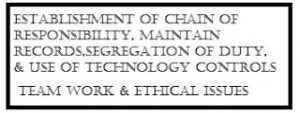ACCOUNTING FINANCIAL STATEMENTS – AN OVERVIEW
Table of Contents
ACCOUNTING FINANCIAL STATEMENTS – AN OVERVIEW – In this article you need to know the 5 types of financial statements, accounting financial statements examples, which financial statement provides information for a specific point in time?, the four basic financial statements, financial statement format, and which financial statement shows money moving in and out of the company during a period of time?
To start with, this article aims at educating clients on what Financial statements are. In this part, we shall consider only one aspect of it; the balance sheet. Other subtopics like Income statements/Profit or lose Account, Cash flow statement etc will be reviewed in our subsequent follow-up articles.
Complete Full Marks Consultants Limited, present these articles as part of its roles in educating her numerous clients, other business proprietors, and the public. CFMC Ltd welcomes enquiries for further information and especially on what it can do to help her client’s business grow. It also has in mind of enriching the knowledge of various students who will read these articles.
READ ALSO: 50 THINGS AN ACCOUNTING FIRM CAN DO FOR YOUR BUSINESS
ACCOUNTING FINANCIAL STATEMENTS – AN OVERVIEW
What is Financial Statement?
As a matter of fact, a financial statement is a financial report of the financial activities and positions of a business, person, or other entity. Such financial information on the financial activities is presented in a structured manner and in a form that is easily understood.
What is a General purpose Financial Statement?
In continuation, this type of Financial statement is known as general purpose financial statements.
General purpose financial statements are usually issued to the general public which is made up of the investment community, lenders, employees and government. These statements are used to discern the financial conditions and results of the issuing entity.
Who uses the Specific Financial Statements?
In addition, a more specific financial statement may also be released. These are not considered to be general purpose because they only give details of a segment, subsidiary, department and locations of the entities.
The management team may want to see detailed departmental activities reports, while a condensed version (general purpose version ) of the income statement may be acceptable for credit reviews by creditors. Other users may not require a complete set of the financial statements, perhaps requesting just the income statement, i.e., the profit and loss account.
ACCOUNTING FINANCIAL STATEMENTS – AN OVERVIEW
THE FOUR BASIC ELEMENTS OF FINANCIAL STATEMENTS:
Consequently,there are four basic elements of financial statements, in addition to management discussion and analysis, for certain category of entities. These include:
1. A balance sheet, also known as a statement of financial position, displaying reports on a company’s assets, liabilities, and owners equity at a given point in time.
2. An income statement, also called statement of comprehensive income, statement of revenue and expense, or profit and loss account, for a period of time. A profit and loss statement provides information on the operations of the enterprise. These include sales (revenue) and the various ( direct cost of production and administrative or operational) expenses incurred during the stated period.
3. A Statement of changes in equity, also known as equity statement or statement of retained earnings, which gives detailed reports on the changes in equity of the company during the stated period.
4. A cash flow statement is a report on a company’s cash flow activities, especially its operating, investing and financing activities.
We will now take up discussion on one element of Financial Statements, Balance Sheet.
READ ALSO: ACCOUNTING AND AUDITING

ACCOUNTING FINANCIAL STATEMENTS – AN OVERVIEW
A BALANCE SHEET
Accounting records are based on what is called fundamental accounting equation which shows Assets as equal to liabilities, which follows an accounting principle that every liability creates an asset, that is to say that, if an entity incurs a debt by buying goods for say N5,000.00, it has also in that same deal gotten asset in the form of the stock bought worth the same N5,000.00. When we see the entity holistically and the owners equity comes in, we then have: assets = liabilities + owners’ equity. With this principle and all transactions posted correctly, the accounts must balance.
In the format of presentation, balance sheet is classified under subheadings such as current assets, fixed assets, current liabilities, Long-term Liabilities. Now you can see that When income statements and cash flow statements are added, it comprises the set of documents indispensable in running a business.
Balance sheet is presented in a condensed statement form that shows the financial position of an entity on a specified date usually the last day of an accounting period. Accounting period is a period of 12 months under which the entity did its transaction, and records are kept on historical bases. These information on Assets, liabilities are shown to show:
(1) what assets the entity owns,
(2) how it paid for them,
(3) what it owes : liabilities, and
(4) what is the amount left after satisfying the liabilities – Net worth
READ ALSO: INSOLVENCY
ACCOUNTING FINANCIAL STATEMENTS – AN OVERVIEW
ACCOUNT KEEPING CLASSIFICATION
Accounts keeping are here classified into two:
– Management Accounts, and
– Audited/statutory Account.
Management Accounts – The Entity’s Management Responsibility.
It is the responsibility of the entity,as stipulated by Nigeria’s Companies and Allied Matters Act (CAMA), for the directors to ensure that proper books of account are kept and that the information contained in them are correct, relevant and complete.
Audited/Statutory Account.
It is this management account that is audited. After auditing the financial statement is published. It is this audited account that is used for various returns that are required by Federal Inland Revenue, Corporate Affairs Commission, and other bodies. An audited balance sheet is often demanded by investors, lenders, suppliers, and taxation authorities as required by law.
The Statutory Auditors Responsibility.
To be considered valid and accepted by the regulatory bodies mentioned above, a balance sheet must give a true and fair view of an organisation’s state of affairs, and must follow the provisions of Generally Accepted Accounting Practice (GAAP) , or International Financial Reporting Standard (IFRS) in its preparation.
ACCOUNTING FINANCIAL STATEMENTS – AN OVERVIEW
These are professional technical financial matters that require you to hire a consultant. You really need one to meet up with all these regulatory agency’s requirements without which you will always run into problem with the said authorities. Complete Full Marks Consultants Limited will ensure you don’t have such problems by giving you all professional assistance you require.

Deacon Anekperechi Nworgu, a seasoned economist who transitioned into a chartered accountant, auditor, tax practitioner, and business consultant, brings with him a wealth of industry expertise spanning over 37 years.



